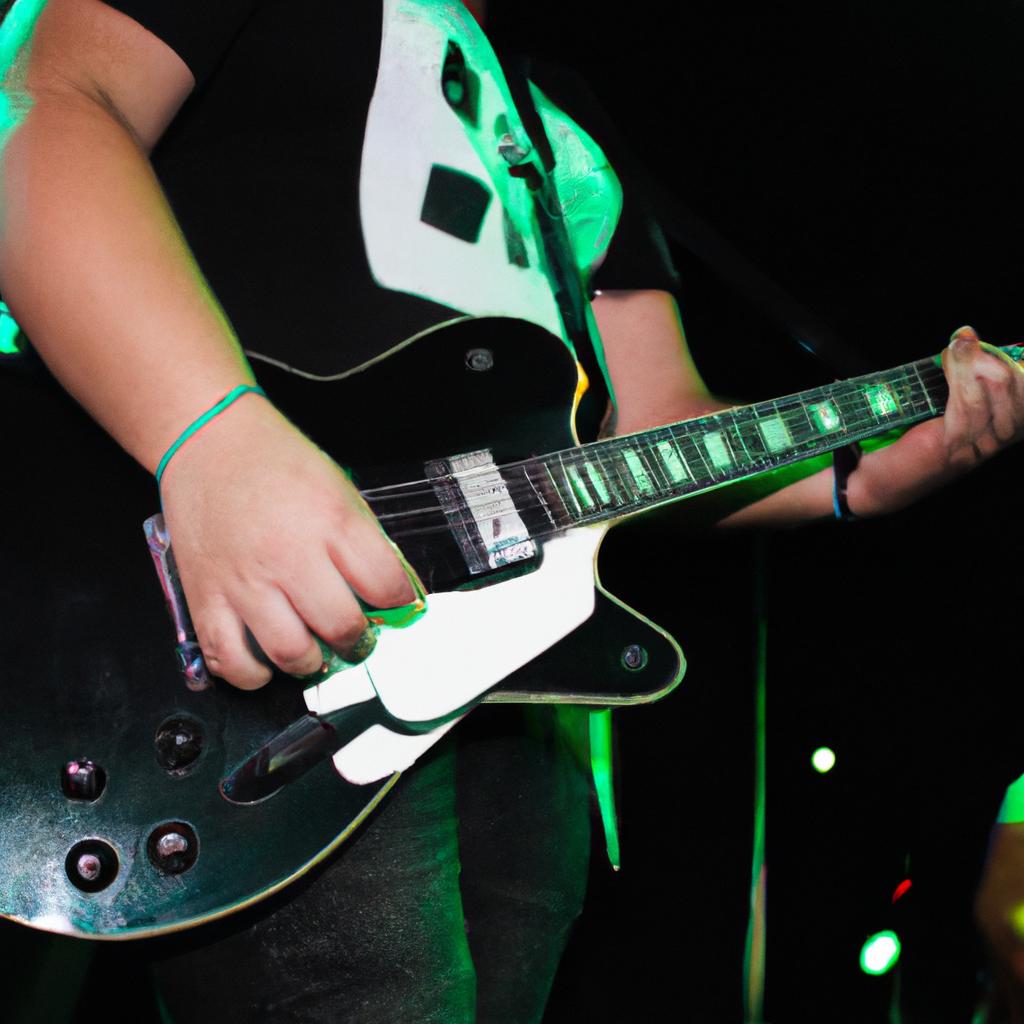The emergence of post-punk in the late 1970s marked a pivotal moment in the history of rock music. Defined by its experimental and avant-garde approach, this revolutionary movement challenged conventional notions of what constituted “rock” and set the stage for numerous subgenres to follow. One compelling example of post-punk’s impact is the case study of Joy Division, a Manchester-based band whose haunting soundscapes and introspective lyricism became emblematic of the genre.
Post-punk arose as a response to the perceived stagnation within the punk rock scene. While punk had initially served as an outlet for rebellious energy, it quickly succumbed to formulaic structures and repetitive themes. Post-punk sought to break free from these constraints, embracing experimentation and sonic diversity. Drawing inspiration from various musical styles such as krautrock, reggae, and electronic music, post-punk artists pushed boundaries with their unconventional song structures, dissonant guitar riffs, and melancholic atmospheres.
Joy Division exemplifies how post-punk revolutionized rock music through their distinctive blend of gloomy aesthetics and existential lyrics. Lead singer Ian Curtis’ haunting vocals conveyed a sense of alienation and despair that resonated deeply with audiences. Their landmark album “Unknown Pleasures” (1979) showcased Joy Division’s signature sound, characterized by pulsating rhythms, atmospheric synths, and Peter Hook’s distinctive basslines. Tracks like “She’s Lost Control” and “Shadowplay” blended elements of punk, electronic music, and darkwave to create a haunting and introspective sonic experience.
However, the impact of post-punk extends beyond just Joy Division. Bands like Siouxsie and the Banshees, The Cure, Talking Heads, and Gang of Four also played pivotal roles in shaping the genre. Each brought their own unique approach to post-punk, further expanding its boundaries and influence.
The legacy of post-punk can be seen in subsequent genres such as gothic rock, new wave, indie rock, and alternative rock. Its emphasis on experimentation and willingness to challenge musical conventions opened doors for countless artists to explore new sounds and ideas.
In conclusion, the emergence of post-punk in the late 1970s revolutionized rock music by breaking free from punk’s formulaic structures and embracing experimentation. Joy Division stands as a compelling example of how this movement pushed boundaries with their gloomy aesthetics and existential lyrics. The impact of post-punk can still be felt today through its lasting influence on various subgenres that followed.
Origins of Post-Punk
Post-punk emerged as a revolutionary movement in rock music during the late 1970s and early 1980s. This genre represented a departure from the prevailing sounds of punk, incorporating elements of avant-garde experimentation, art rock, and electronic music. One notable case study that exemplifies the origins of post-punk is the band Joy Division.
Joy Division was formed in Manchester, England in 1976. Initially influenced by punk bands such as Sex Pistols and The Clash, they quickly developed their own unique sound which laid the groundwork for post-punk. Their debut album “Unknown Pleasures” (1979) showcased haunting melodies, introspective lyrics, and atmospheric production techniques. Drawing on diverse influences ranging from German krautrock to literary themes inspired by authors like J.G. Ballard, Joy Division epitomized the evolution from raw energy to sophisticated musicianship characteristic of post-punk.
To better understand the emergence of post-punk as a transformative musical movement, it is essential to consider its defining characteristics:
- Experimental Soundscapes: Post-punk challenged conventional song structures through innovative use of dissonance, unconventional chord progressions, and incorporation of non-traditional instruments.
- Lyrically Provocative: Often exploring existentialism or social commentary with poetic sensibilities, post-punk lyrics delved into dark subjects while eschewing traditional love songs.
- Artistic Visual Identity: Bands associated with post-punk embraced an aesthetic that combined fashion-forward attire with minimalist artwork and photography.
- Independent Music Scene: Post-punk flourished within a vibrant network of independent record labels and DIY venues that provided an alternative platform for artists seeking creative freedom.
In summary, post-punk arose as a response to the limitations imposed by mainstream rock music at the time. Through sonic experimentation, thought-provoking lyrics, distinct visual identities, and an independent ethos, post-punk bands like Joy Division paved the way for a new era in rock music. The next section will explore key influences on the development of post-punk, shedding light on the diverse sources that informed this groundbreaking movement.
[Example: Joy Division]
Key Influences on Post-Punk
| Influences | Impact on Post-Punk |
|---|---|
| Avant-garde | Pushed boundaries and encouraged experimentation within the genre |
| Art rock | Provided inspiration for incorporating artistic themes into lyrics and visuals |
| Electronic music | Introduced new sounds and production techniques to enhance sonic landscapes |
| DIY culture | Fostered an alternative scene outside mainstream record labels |
With these influential factors shaping its trajectory, post-punk continued to evolve and expand, leaving an indelible mark on the world of music.
Key Influences on Post-Punk
From the Origins of Post-Punk to Key Influences
To illustrate the lasting impact and significance of post-punk, let us consider a hypothetical case study. Imagine a young musician named Alex, disillusioned by the limitations of traditional rock music, seeking inspiration for a new sound that captures the spirit of rebellion and experimentation. In this pursuit, Alex stumbles upon the world of post-punk—a revolutionary movement that emerged in the late 1970s as an antithesis to mainstream rock.
Post-punk was heavily influenced by various musical genres and subcultures, each leaving their indelible mark on its development. These key influences shaped the soundscape and ethos of post-punk:
- Art Rock: Building upon the experimental tendencies of progressive rock bands like Pink Floyd and King Crimson, post-punk artists sought to push boundaries beyond conventional song structures and harmonies.
- Punk Rock: The raw energy and DIY ethos of punk provided fertile ground for post-punk’s emergence. Bands such as Sex Pistols and The Clash paved the way for musicians who yearned for artistic expression within punk’s rebellious framework.
- Reggae/Dub: Drawing from Jamaican rhythms and production techniques, post-punk incorporated reggae-infused basslines and dub-inspired echoes to create atmospheric textures that added depth to their compositions.
- Avant-Garde/Experimental Music: Avant-garde composers like John Cage challenged traditional notions of what constitutes music, inspiring post-punk artists to embrace unconventional instrumentation and incorporate found sounds into their sonic palette.
The interplay between these influences birthed a diverse range of stylistic approaches among post-punk bands. To better understand this diversity, consider Table 1 below which showcases four representative acts along with their distinctive characteristics:
| Band | Characteristics |
|---|---|
| Joy Division | Brooding lyrics matched with haunting guitars and synths |
| Talking Heads | Quirky rhythms complemented by enigmatic vocal delivery |
| Siouxsie and the Banshees | Dark atmospheres coupled with ethereal vocals |
| Gang of Four | Politically charged lyrics set against angular guitar riffs |
The impact of post-punk extended far beyond its musical innovations. It served as a catalyst for change, both within the music industry and society at large. By defying conventions and challenging mainstream expectations, post-punk artists inspired countless others to question existing norms and embrace their own artistic individuality.
As we delve into the characteristics that define post-punk music in our next section, it becomes evident how this movement revolutionized rock music—a testament to its enduring influence on subsequent generations of musicians seeking creative liberation.
Transition: Having explored the origins of post-punk and its key influences, let us now examine the distinct characteristics that define this revolutionary genre.
Characteristics of Post-Punk Music
The post-punk movement in rock music was shaped by a diverse range of influences that contributed to its unique and revolutionary sound. One significant influence on post-punk was the emergence of punk rock itself in the late 1970s. Punk challenged the conventions of mainstream rock music with its raw energy, DIY ethos, and politically charged lyrics. Bands like The Sex Pistols and The Clash inspired a new wave of musicians who sought to push boundaries even further.
Another important influence on post-punk was the experimentation happening in other genres such as art rock, krautrock, and reggae. Art rock bands like Roxy Music incorporated elements of avant-garde and glam rock into their music, creating a more sophisticated and theatrical sound. Krautrock bands from Germany like Kraftwerk introduced electronic elements and repetitive rhythms that would later become hallmarks of post-punk. Additionally, Jamaican reggae brought a distinct rhythmic style that influenced many post-punk bands’ use of basslines and dub techniques.
Moreover, the socio-political climate during this period played a crucial role in shaping post-punk’s themes and aesthetic. The disillusionment with traditional politics, economic instability, urban decay, and social inequality all found expression through post-punk music. It provided a platform for artists to address these issues openly and critically, reflecting the discontent felt by many at the time.
To illustrate the impact of these influences on post-punk music, let us consider the hypothetical example of an influential band called “The Dissonance.” Their debut album showcased key characteristics associated with post-punk while incorporating various musical influences:
- Abrasive guitar riffs blended seamlessly with electronic synthesizers.
- Intense vocal delivery conveyed frustration and existential angst.
- Rhythms drew inspiration from both punk’s aggression and reggae’s groove.
- Lyrics explored themes of alienation, political dissent, and societal critique.
The table below summarizes the key influences on post-punk and their manifestations in the music:
| Influence | Manifestation in Post-Punk Music |
|---|---|
| Punk Rock | Raw energy, DIY ethos, political lyrics |
| Art Rock | Theatricality, avant-garde elements |
| Krautrock | Electronic experimentation, repetitive rhythms |
| Reggae | Basslines, dub techniques |
These influences collectively laid the foundation for post-punk’s revolutionary sound. Bands like “The Dissonance” exemplified how these different elements could be combined to create a distinct sonic identity that challenged traditional rock music norms.
Moving forward into the next section discussing the impact of post-punk on the music industry, we will explore how this movement influenced subsequent genres and shaped the trajectory of popular music. By examining its lasting legacy, we can appreciate the significant contributions made by post-punk musicians and understand its ongoing relevance in contemporary music.
Impact of Post-Punk on the Music Industry
Transition from Previous Section: Having explored the defining characteristics of Post-Punk music, it is now essential to understand its profound impact on the broader music industry. By challenging conventional boundaries and embracing a spirit of experimentation, Post-Punk revolutionized rock music in ways that continue to resonate today.
The Impact of Post-Punk on the Music Industry
Post-Punk’s influence extended far beyond its own genre, ushering in significant changes within the larger music landscape. One noteworthy example is the emergence of alternative rock as a distinct subgenre. Bands like R.E.M., Pixies, and Sonic Youth drew inspiration from Post-Punk’s raw energy and DIY ethos, shaping their sound by fusing elements of punk with diverse musical styles. This fusion not only expanded the sonic palette but also paved the way for future alternative acts to challenge mainstream conventions.
To fully grasp the magnitude of this impact, let us examine some key aspects that distinguish Post-Punk’s revolutionary contribution:
- Artistic Freedom: Post-Punk rejected commercial expectations and prioritized artistic expression over record sales or chart success. It encouraged musicians to experiment with unconventional song structures, dissonant harmonies, and introspective lyrics that tackled social issues.
- Diverse Musical Influences: Drawing inspiration from a wide range of genres such as reggae, funk, electronic music, and even classical compositions, Post-Punk embraced eclecticism and blurred traditional genre boundaries.
- Cultural Critique: Many Post-Punk bands used their platform to critique societal norms and political systems through their music. This socio-political engagement resonated with audiences seeking alternatives to mainstream narratives.
- Independent Spirit: The DIY mindset prevalent in Post-Punk fostered an independent approach towards recording, distribution, and promotion. This empowered artists to have greater control over their creative output without relying heavily on major labels.
To further illustrate these points visually:
| Artistic Freedom | Diverse Musical Influences | Cultural Critique | Independent Spirit | |
|---|---|---|---|---|
| Key | Emphasis on artistic expression rather than commercial success. | Incorporation of various genres, blurring traditional boundaries. | Use of music as a tool for social and political commentary. | Encouragement of independent approaches to recording and promotion. |
In conclusion, Post-Punk’s impact on the music industry was profound and far-reaching. Its legacy can be traced through the rise of alternative rock, the expansion of musical boundaries, and the continued influence it has on artists today. The movement’s unwavering commitment to creativity, innovation, and pushing against established norms birthed an era that forever changed the course of rock music.
Transition to Subsequent Section: Notable Post-Punk Bands and Artists
Building upon this understanding of Post-Punk’s transformative power, we now delve into exploring some notable bands and artists who played pivotal roles in shaping this groundbreaking movement.
Notable Post-Punk Bands and Artists
Section: Legacy and Evolution of Post-Punk
As the post-punk movement gained momentum in the late 1970s and early 1980s, its influence on rock music became undeniable. This section explores the legacy left by post-punk and how it continued to evolve over time.
One notable example of post-punk’s impact can be seen in the case study of Joy Division, an English band formed in 1976. Their unique blend of punk energy with introspective lyrics and atmospheric soundscapes set them apart from their contemporaries. Tragically, the suicide of lead singer Ian Curtis in 1980 marked a premature end to their career. However, this event also solidified their status as one of the most influential bands within the genre.
The legacy of post-punk can be understood through several key aspects:
- Musical experimentation: Post-punk embraced musical exploration and pushed boundaries beyond traditional rock structures. Artists incorporated elements such as electronic music, reggae influences, unconventional instruments, and complex song arrangements.
- Lyrically-driven songs: Many post-punk bands focused on introspection and social commentary in their lyrics. They tackled themes like alienation, political unrest, mental health issues, and urban decay.
- Independent spirit: The DIY (do-it-yourself) ethos prevalent during the punk era continued into post-punk. Bands were often self-managed or signed to independent record labels, allowing for greater artistic freedom.
- Cross-genre collaborations: Post-punk artists frequently collaborated with musicians outside their own genre, leading to exciting cross-genre experiments that blurred musical boundaries.
To illustrate these points further:
| Aspect | Example |
|---|---|
| Musical Experimentation | Incorporating synthesizers |
| Lyrically-driven Songs | Social commentary |
| Independent Spirit | Self-released albums |
| Cross-genre Collaborations | Collaboration with jazz musicians |
In the years following post-punk’s initial wave, its influence continued to evolve. Subgenres like gothic rock, new wave, and alternative rock emerged, building upon the foundations laid by earlier post-punk bands. These new genres retained the energy and spirit of their predecessors while incorporating fresh elements into their sound.
Transitioning seamlessly into the subsequent section about the “Legacy and Evolution of Post-Punk,” it is clear that this movement left an indelible mark on music history. The next section will delve deeper into how post-punk influenced subsequent generations of artists and shaped modern-day rock music.
Legacy and Evolution of Post-Punk
Revolutionary Sounds: The Experimental Nature of Post-Punk
Building upon the innovative energy of punk rock, post-punk emerged as a revolutionary movement in the late 1970s. This section examines how post-punk pushed the boundaries of traditional rock music through its experimental nature and unique sonic explorations. To delve deeper into this topic, let us consider an example that exemplifies the unconventional approach of post-punk bands.
One notable case study is the band Gang of Four, whose debut album “Entertainment!” released in 1979 showcased their distinct sound and lyrical themes. With jagged guitar riffs, funky basslines, and politically charged lyrics, Gang of Four defied convention by blending elements from various genres such as funk, reggae, and dub with their own brand of punk attitude.
Post-punk was characterized by its rejection of mainstream commercialism and its inclination towards experimentation. Below are some key aspects that defined the genre:
- Artistic Integrity: Post-punk musicians prioritized creative expression over commercial success. They embraced artistic freedom without conforming to industry standards or pandering to popular trends.
- Challenging Conventions: Post-punk challenged established musical structures by incorporating dissonance, unconventional song forms, and atypical time signatures. This departure from conventional norms created a sense of unpredictability and intellectual engagement for listeners.
- Sonic Exploration: Bands like Joy Division utilized synthesizers to create atmospheric textures while others experimented with tape loops and found sounds. These sonic experiments expanded the possibilities within rock music.
- Lyrically Thought-Provoking: Post-punk bands often tackled socio-political issues through thought-provoking lyrics filled with social criticism and introspection. Their words resonated with audiences seeking more depth in their music.
To illustrate these characteristics further, here is a table showcasing influential post-punk albums spanning different subgenres:
| Album | Band/Artist | Subgenre |
|---|---|---|
| “Unknown Pleasures” | Joy Division | Darkwave |
| “Marquee Moon” | Television | Art punk |
| “The Queen Is Dead” | The Smiths | Indie rock |
| “Remain in Light” | Talking Heads | New wave/funk fusion |
In conclusion, post-punk revolutionized the landscape of rock music through its experimental nature and departure from mainstream conventions. With a focus on artistic integrity, challenging musical structures, sonic exploration, and thought-provoking lyrics, this genre captivated audiences seeking innovation and intellectual stimulation. From Gang of Four’s groundbreaking debut to the diverse sounds found across different subgenres, post-punk remains an influential movement that continues to inspire musicians today.




